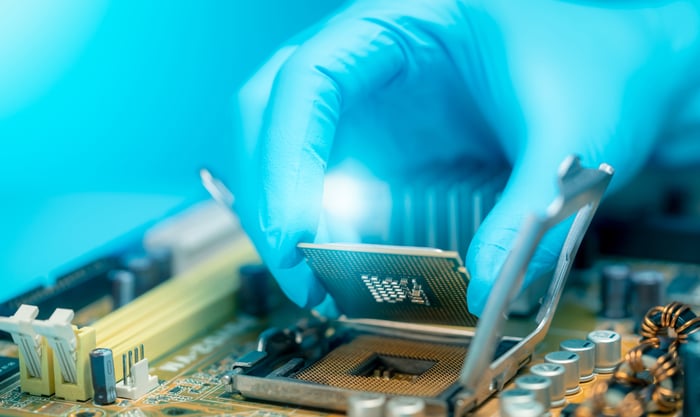|
|
|

|
|||||

|
|
Intel blasted higher in September on the back of Nvidia's $5 billion investment and announced product partnership.
The collaboration should go a long way toward stabilizing and perhaps growing Intel's market share in PCs and servers.
Despite the dilution, Nvidia's vote of confidence led the stock to surge.
Shares of Intel (NASDAQ: INTC) rallied 37.8% in September, according to data from S&P Global Market Intelligence.
Intel had already experienced a momentous month in August after the U.S. government converted its CHIPS Act grant money into roughly a 9% equity stake, while Japanese tech giant Softbank invested another $2 billion.
Where to invest $1,000 right now? Our analyst team just revealed what they believe are the 10 best stocks to buy right now, when you join Stock Advisor. See the stocks »
Those investments, while notable, were dwarfed in significance by last month's $5 billion investment from AI leader Nvidia (NASDAQ: NVDA), which also came along with an announcement of two key product partnerships.
Attracting the investment of arguably the world's most important AI company sent beaten-down Intel's stock soaring in September.

Image source: Getty Images.
There were three major components to the Nvidia-Intel announcement: two product partnerships, along with Nvidia's $5 billion investment in Intel stock at $23.28 per share -- good for about a 4% ownership stake.
On the product-level partnership, Intel will integrate its data center CPUs more tightly with Nvidia's leading AI GPU server ecosystem, while Nvidia will more closely integrate its graphics GPU technology with Intel's leading CPU architecture for PCs, where Intel still holds a large market share.
In order to make fully integrated AI servers, which still require a CPU, Nvidia has developed its own internally designed "Grace" CPUs based on the Arm Holdings architecture in recent years. However, Arm CPUs are generally known for their power efficiency, not performance. Meanwhile, most enterprise data center servers are still tied to the x86 CPU architecture, not Arm. As such, Intel's performance-optimized Granite Rapids Xeon 6 CPU, which came out last year, became the reference design as the "host" CPU in Nvidia's new DGX B300 server systems.
The two companies will now bring Nvidia's GPU and Intel's x86 CPU architectures even closer together, with Intel giving Nvidia the ability to customize its own CPU design on Intel's x86 CPU architecture for future AI systems.
And while Nvidia dominates AI servers, Intel, despite having lost its near-monopoly from a decade ago, still commands over 76% of the consumer PC market. Nvidia already sells discrete RTX graphics chips to the high-end gaming PC market, but has been somewhat left out of a large part of the PC market that demands close integration of graphics and central processing units on the same system-on-chip (SOC).
While Intel also has its own line of Arc graphics chips, Intel will now integrate Nvidia's RTX graphics chiplets directly into Intel's x86 SOCs for the part of the PC market where integrated SOCs are required. The tie-up will thus expand Nvidia's addressable market in PCs, while Nvidia's premium graphics brand and IP should help Intel win back market share.
As was the case with the U.S. government's investment, Intel's stock took off on the news, despite the effects of shareholder dilution. This is likely due to the halo effect of being in league with Nvidia, which is currently seen as the gold standard in graphics and AI. Intel has suffered from a crisis of confidence and market share losses in recent years, so to get a vote of confidence from Nvidia at this time goes a long way.
And while some analysts were skeptical there was no announcement for Nvidia to use Intel's nascent foundry manufacturing services, the lack of an announcement today doesn't mean there couldn't be a foundry deal for Nvidia chips down the road. Meanwhile, Nvidia's investment indicates confidence in Intel's technology roadmap and future, which includes its foundry efforts.
On that note, Intel is currently hosting tech and financial analysts at its new 18A fabs in Arizona this week, and is set to formally introduce its Panther Lake and Clearwater Forest chips on Thursday, Oct. 9. These will be the first internal products made on Intel's new 18A process node, which Intel believes could bring it back to semiconductor technology leadership once again.
Before you buy stock in Intel, consider this:
The Motley Fool Stock Advisor analyst team just identified what they believe are the 10 best stocks for investors to buy now… and Intel wasn’t one of them. The 10 stocks that made the cut could produce monster returns in the coming years.
Consider when Netflix made this list on December 17, 2004... if you invested $1,000 at the time of our recommendation, you’d have $621,976!* Or when Nvidia made this list on April 15, 2005... if you invested $1,000 at the time of our recommendation, you’d have $1,150,085!*
Now, it’s worth noting Stock Advisor’s total average return is 1,058% — a market-crushing outperformance compared to 191% for the S&P 500. Don’t miss out on the latest top 10 list, available when you join Stock Advisor.
*Stock Advisor returns as of September 29, 2025
Billy Duberstein has positions in Intel. The Motley Fool has positions in and recommends Intel and Nvidia. The Motley Fool recommends the following options: short November 2025 $21 puts on Intel. The Motley Fool has a disclosure policy.
| 55 min | |
| 2 hours | |
| 2 hours | |
| 3 hours | |
| 4 hours | |
| 6 hours | |
| 6 hours | |
| 11 hours | |
| Dec-06 | |
| Dec-06 | |
| Dec-06 | |
| Dec-06 | |
| Dec-06 | |
| Dec-06 | |
| Dec-06 |
Join thousands of traders who make more informed decisions with our premium features. Real-time quotes, advanced visualizations, backtesting, and much more.
Learn more about FINVIZ*Elite